#234 Tomorrow's picture: February 08, 1996
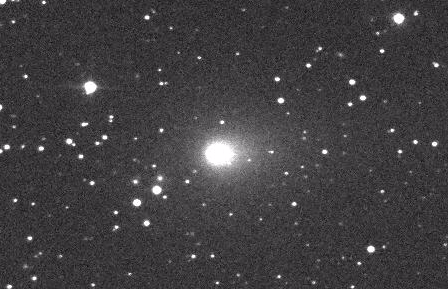
“Get ready for one of the most impressive but least anticipated light shows in modern astronomical history. Next month, newly discovered Comet Hyakutake will pass closer to the Earth than any recent comet. Unknown before its discovery by Yuji Hyakutake on 30 January 1996, the fuzzy spot in the above photograph is a comet now predicted to become bright enough to see without a telescope. Although comets act in such diverse ways that predictions are frequently inaccurate, even conservative estimates indicate that this comet is likely to impress. For example, even if Comet Hyakutake remains physically unchanged, its close pass near the Earth in late March 1996 should cause it to appear to brighten to about 3rd magnitude - still bright enough to see with the unaided eye. In the next two months, though, the comet will continue to approach the Sun and hence should become brighter still. Optimistic predictions include that Comet Hyakutake will change physically, develop a larger coma and tail, brighten dramatically, move noticeably in the sky during a single night, and may ultimately become known as the "The Great Comet of 1996." Move over Hale-Bopp!"
Copyright: Gordon
Garradd
#235 Tomorrow's picture: February 09, 1996
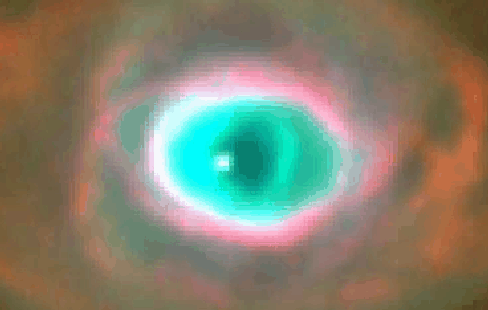
“What's happening in the eye-like center of this planetary nebula? The geometry revealed in this Hubble Space Telescope view of the central part of an "etched hourglass nebula" known as MyCn 18 presents a puzzle. First, the axis of this central region does not line up well with the outer hourglass structure. Next, the hot star (the white spot to the left of center) which ejected this gaseous nebula as it evolved towards its white dwarf phase, is not exactly at the center of the "eye". These unexpected results leave astronomers looking for the missing pieces of the ejection process that created this unusual and beautiful structure."
Copyright: Public domain
#236 Tomorrow's picture: February 10, 1996
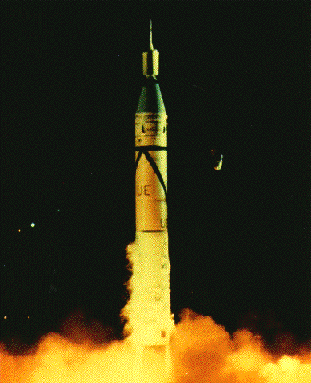
“The first US spacecraft was Explorer 1. The cylindrical 30 pound satellite was launched (above) as the fourth stage of a Jupiter-C rocket (a modified US Army Redstone ballistic missile) and achieved orbit on January 31, 1958. Explorer I carried instrumentation to measure internal and external temperatures, micrometeorite impacts, and an experiment designed by James A. Van Allen to measure the density of electrons and ions in space. The measurements made by Van Allen's experiment led to an unexpected and startling discovery - an earth-encircling belt of high energy electrons and ions trapped in the magnetosphere - now known as the Van Allen Belt. Explorer I ceased transmitting on February 28 of that year but remained in orbit until March of 1970."
Copyright: Public domain
#237 Tomorrow's picture: February 11, 1996
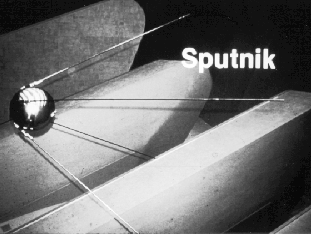
“Sputnik means "traveling companion". In stark contrast to this innocent sounding name, the launch of the Earth's first "artificial moon", Sputnik 1, by the Soviets on October 4, 1957 shocked the free world, setting in motion events which resulted in the creation of NASA and the race to the Moon. Sputnik I was a 184 pound, 22 inch diameter sphere with four whip antennas connected to battery powered transmitters. The transmitters broadcast a continuous "beeping" signal to an astounded earthbound audience for 23 days. A short month later, on November 3, the Soviets followed this success by launching a dog into orbit aboard Sputnik 2."
Copyright: Public domain
#238 Tomorrow's picture: February 12, 1996
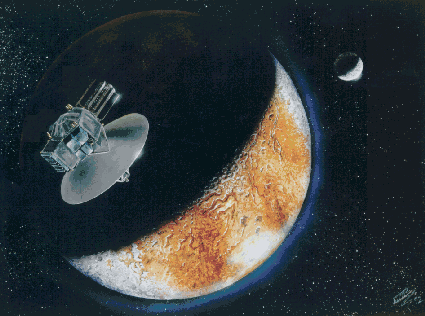
“Cold, distant, Pluto is the only planet in our Solar System which has not been visited by a spacecraft from Earth. The story goes that the legend "Pluto Not Yet Explored" on a US postal stamp depicting the tiny, mysterious world inspired a JPL employee to develop plans for a Pluto flyby. These plans evolved into the current "Pluto Express" mission intended for launch early in the next decade. The type of small, high-tech spacecraft proposed is depicted above in an artist's vision approaching Pluto's mottled surface. A tenuous, transient atmosphere is visible as blue haze beyond the bright limb while Pluto's companion Charon looms in the distance. Images and data from such a mission would be an incredible boon to those studying these bizarre, inaccessible worlds as evidence mounts that Pluto itself is only the largest of many small ice dwarf mini-planets. Some have dubbed the yet unexplored Pluto-Charon system the last "astronomers' planet". Note: Pluto's discoverer, astronomer Clyde Tombaugh, celebrated his 90th birthday on February 4."
Copyright: Public domain
#239 Tomorrow's picture: February 13, 1996
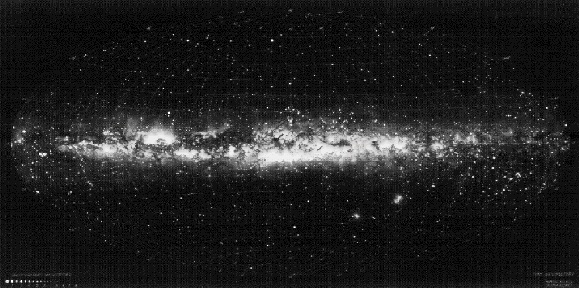
“This panorama view of the sky is really a drawing. It was made in the 1940s under the supervision of astronomer Knut Lundmark at the Lund Observatory in Sweden. To create the picture, draftsmen used a mathematical distortion to map the entire sky onto an oval shaped image with the plane of our Milky Way Galaxy along the center and the north galactic pole at the top. 7,000 individual stars are shown as white dots, size indicating brightness. The "Milky Way" clouds, actually the combined light of dim, unresolved stars in the densely populated galactic plane, are accurately painted on, interrupted by dramatic dark dust lanes. The overall effect is photographic in quality and represents the visible sky. Can you identify any familiar landmarks or constellations? For starters, Orion is at the right edge of the picture, just below the galactic plane and the Large and Small Magellanic Clouds are visible as fuzzy patches in the lower right quadrant."
Copyright: Public domain
#240 Tomorrow's picture: February 14, 1996

“Would the Rosette nebula by any other name look as sweet? The bland New General Catalog designation of NGC 2237 doesn't appear to diminish the appearance of the this flowery emission nebula. Inside the nebula lies an open cluster of bright young stars designated NGC 2244. These stars recently formed from the nebular material and their stellar "wind" has cleared a hole in the nebula's center, insulated by a layer of dust and hot gas. Ultraviolet light from the hot cluster stars causes the surrounding nebula to glow."
Copyright: Public domain
Upvote! Resteem! Comment! As you like it! Thank you for attention!